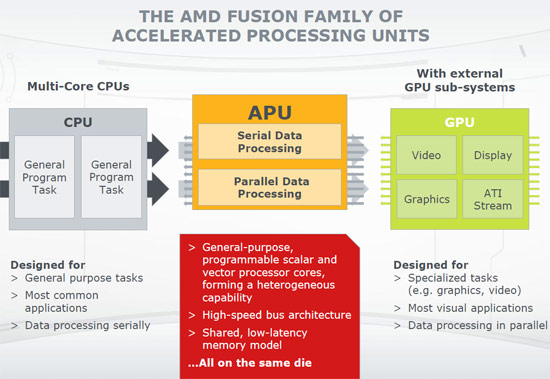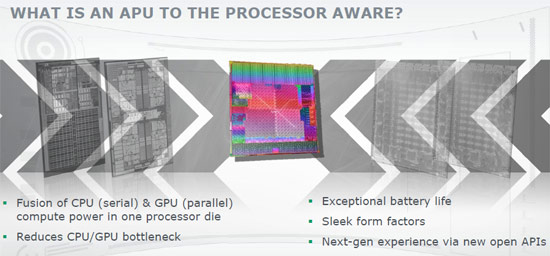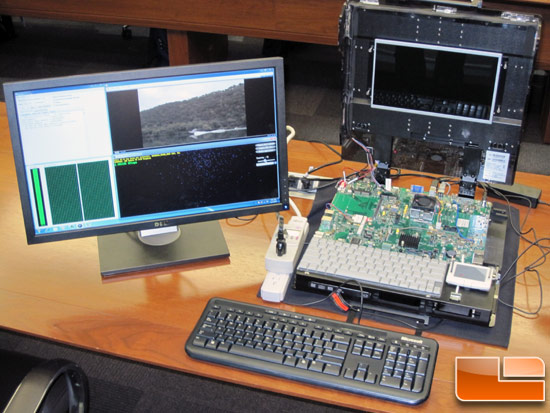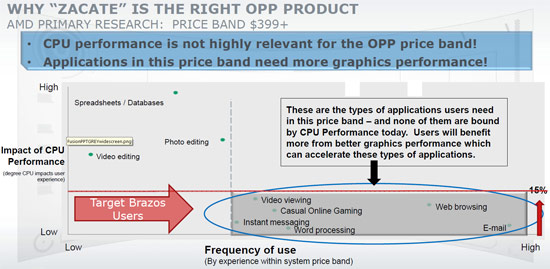AMD Vision – The $399 Brazos Notebook Platform Preview
AMD Vision – Fusion APU Update
Last week we had the opportunity to visit AMD’s Austin, Texas headquarters to preview their upcoming ‘Brazos’ development platform and actually got some hands-on testing with a Fusion APU system prior to its launch. AMD is allowing us to post up a little bit of information on this upcoming platform today, but the performance numbers that we recorded are under still under embargo. Today, we will be bringing you some high-level impressions, chip architecture details and pictures of an MSI notebook that is running an AMD APU called Zacate.

Before we dive into what we saw, it might be a good idea to explain what AMD Fusion and what an APU is. AMD Fusion is a new approach to processor design and software development, that combines CPU and GPU capabilities for HD, 3D and data-intensive workloads into a single-die processor called an Accelerated Processing Unit (APU). APUs combine high-performance serial and parallel processing cores with other special-purpose hardware accelerators, enabling improved performance when it comes to visual computing, security, performance-per-watt and device form factor.

To those that know about processors, this new design means that the data bottleneck between the CPU and GPU will be greatly reduced and the battery life and form factors for notebooks will improve since you really only need an APU and a south bridge chipset for a mobile solution now.

AMD let us take a sneak peak at the Brazos platform, which is their entry level product for the AMD Vision product line. The Brazos platform is made up of ‘Ontario’ and ‘Zacate’ APU’s. Both of these processors are made by The entry level will be Ontario 9W processors that are designed for HD content and internet browsing capabilities. The Ontario APU will be sold with C-Series APU branding and will be available at launch as the C-30 and C-50. Those wanting more horse power can step up to AMD’s ‘Mainstream HD Entertainment’ processor, which is the 18W Zacate APU. This APU competes with the Intel Pentium CPU series and will be branded an E-Series APU with E-240 and E-350 models available at launch.
List of upcoming Brazos APUs:
All models below have 512KB L2 cache-per-core and support up to 1066MHz DDR3, come with UVD3 and AMD-V technology
Zacate (18W max)
- AMD E-350 with AMD Radeon HD 6310 Graphics (dual-core CPU @ 1.6GHz & DX-11 SIMD @ 500MHz)
- AMD E-240 with AMD Radeon HD 6310 Graphics (single-core CPU @ 1.5GHz & DX-11 SIMD @ 500MHz)
Ontario (9W max)
- AMD C-50 with AMD Radeon HD 6250 Graphics (dual-core CPU @ 1.0GHz & DX-11 SIMD @ 280MHz)
- AMD C-30 with AMD Radeon HD 6250 Graphics (single-core CPU @ 1.2GHz & DX-11 SIMD @ 280MHz)

The platform that we got to see and actually use is a Brazos platform with the AMD Zacate processor. The specific processor that we got to use was the E-350. Before we get into the architecture details let’s take a look at a demo that AMD showed us at the start of our day.
AMD showed this proof of concept heterogeneous demo shows an AMD E-350 APU with AMD Radeon HD 6310 graphics on-board running Hyper-Pi 32M at full 100% load on both x86 ‘Bobcat’ CPU cores, a high-performance computing application on the GPU compute engine and the 3rd Generation Unified Video Decoder (UVD) playing 1080P video content all at the same time. How much do you think a whole notebook platform based on this APU will cost?

AMD has targeted this processor and platform at the $399 price point! This is a mainstream platform and obviously it should have a price tag that easily makes it affordable to the masses. Let’s take a look at the architecture details and see how this was made possible all on a single chip at just 1.6GHz.

Comments are closed.